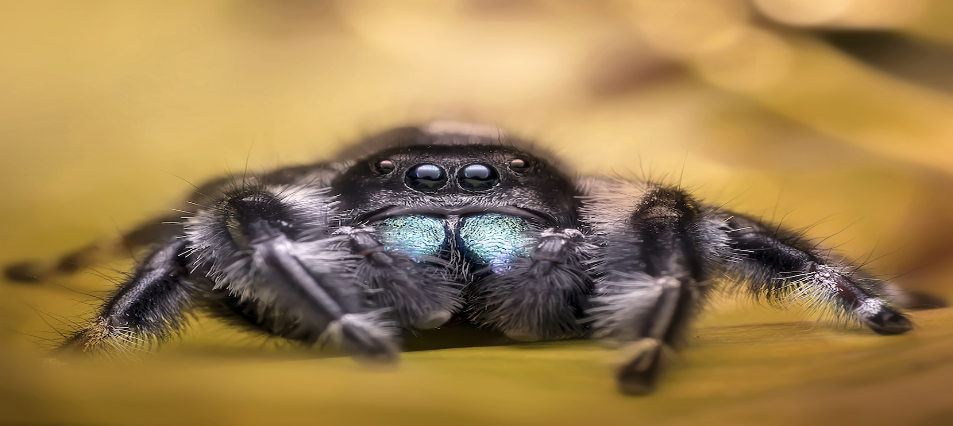
Getting to know the Jumping Spiders
Jumping spiders are small spiders that jump to catch their prey. This is why they are named the Jumping Spider. The spider is small and is rarely found in homes. They prefer the outdoors and their habitat is also outdoors.
Many people are afraid of the spiders because they are easily confused with the black widow spider. To understand these spiders, you need to take the time to learn as much about them as possible. Then, you will see a completely different side to the jumping spider.
What is the jumping spider?
Because of their small size, they need to jump on top of their prey to catch it. This is the main reason for their name “jumping spiders”. Because they jump to find prey and to fight predators, people are afraid of them. No one wants to have a spider that jumps onto them.
They belong to the Family Salticidae and there are more than 4 000 species of them. Most species can be found in the United States and Canada. The jumping spider comes in a variety of different colors which include black, brown, grey with white with different color markings. The adult spider is between 4-18 mm and has a coat of dense hair or scales. These hair and scales are normally a bright color to scare off their predators.
Their main features
It’s their main features that make these spiders cute and interesting. They are different from other spiders, just because they can jump and they are very small. These are some of the main features of jumping spiders.
- Color is normally black with pale markings. Other species are brown or gray.
- They are small and the adults are only between 4 and 18 mm.
- They have normal 8 legs just like other spiders, but they don’t have any antennae.
- Can mostly be found outside on trees and flowers.
Their habitat
These spiders have interesting habitats. You will rarely find them in homes or buildings. If you find one indoors, it might be because they found themselves indoors, when hunting. They can mostly be found in tropical forests, deserts, intertidal zones, and mountains.
In residential areas, you will find these spiders in your garden and on the grass in parks. This is where they prefer living and where catching prey is the easiest. Most of the spider’s prey are larger than them, and they need to be fast and surprising their prey to kill them.
Can Jumping spiders bite humans, and is it poisonous
Because jumping spiders can jump on humans, people are afraid of these spiders. They are so small that you won’t find one when you search yourself, after seeing one. It might come as a surprise, but they aren’t poison. The only reason why they will bite is when they are threatened.
When you are bitten by a jumping spider, most symptoms can be asymptomatic. There will not be any signs that you were bitten. Most people have reported that the bite of a jumping spider is similar to a mosquito bite and can become red, feel stinging, and mild swelling. There were reports of being allergic to the bite and then the symptoms can become more serious. In this case, you should seek medical attention right away.
Should you get rid of jumping spiders?
There is no reason why you should get rid of jumping spiders. Even if you found them in your home. They are harmless and won’t harm you unless they are frightened. There is no reason for humans to kill jumping spiders, and you won’t need any insecticides or pesticides. They are eating the flies and mosquitos around your home, and this is the main reason why you should leave them alone.
If you find one in your home, they might need to be rescued and set free in your garden. They should not be indoors, because this isn’t their habitat. The catch them, you need to be careful not to harm them. They are small and will jump when they are scared.

If you like jumping spiders, or find it interesting, you might want to have your own jumping spider model. You can find these spiders in the Steam Punk 3D metal puzzle. Then, you can look at your own spider and remind yourself not to kill these spiders when they come into your home.
FAQ
1.Do jumping spiders bite?
Jumping spiders do bite on occasion, but it is rare and their venom is not dangerous to humans. Their bites may cause mild pain, redness, and swelling
2.How long do jumping spiders live?
The lifespan of jumping spiders typically ranges from six months to two years in the wild, but they can live up to three years in captivity. Males usually have shorter lifespans compared to females
3.What do jumping spiders eat?
Jumping spiders are carnivorous and primarily feed on insects such as flies, moths, and crickets. Some species have been observed consuming nectar from flowers as well
4.Where do jumping spiders live?
Jumping spiders are found all over the world except Antarctica. They prefer outdoor habitats like tropical forests, grasslands, and deserts, but they can also be found indoors near windows and doors where they hunt for prey
5.Do jumping spiders really jump?
Yes, jumping spiders are known for their remarkable jumping ability, which they use to catch prey or escape from threats. They can leap up to 6.3 inches
6.Can jumping spiders recognize their owners?
While there is no scientific proof that jumping spiders can recognize their owners, some pet owners believe that these spiders may be able to recognize and remember them

